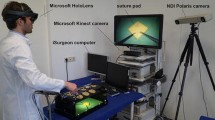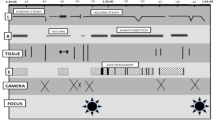Abstract
Background
Technical advances in the application of laparoscopic and robotic surgical systems have improved platform usability. The authors hypothesized that using two monitors instead of one would lead to faster performance with fewer errors.
Methods
All tasks were performed using a surgical robot in a training box. One of the monitors was a standard camera with two preset zoom levels (zoomed in and zoomed out, single-monitor condition). The second monitor provided a static panoramic view of the whole surgical field. The standard camera was static at the zoomed-in level for the dual-monitor condition of the study. The study had two groups of participants: 4 surgeons proficient in both robotic and advanced laparoscopic skills and 10 lay persons (nonsurgeons) who were given adequate time to train and familiarize themselves with the equipment. Running a 50-cm rope was the basic task. Advanced tasks included running a suture through predetermined points and intracorporeal knot tying with 3–0 silk. Trial completion times and errors, categorized into three groups (orientation, precision, and task), were recorded.
Results
The trial completion times for all the tasks, basic and advanced, in the two groups were not significantly different. Fewer orientation errors occurred in the nonsurgeon group during knot tying (p = 0.03) and in both groups during suturing (p = 0.0002) in the dual-monitor arm of the study. Differences in precision and task error were not significant.
Conclusions
Using two camera views helps both surgeons and lay persons perform complex tasks with fewer errors. These results may be due to better awareness of the surgical field with regard to the location of the instruments, leading to better field orientation. This display setup has potential for use in complex minimally invasive surgeries such as esophagectomy and gastric bypass. This technique also would be applicable to open microsurgery.




Similar content being viewed by others
References
Southern Surgical Society (1991) A prospective analysis of 1,518 laparoscopic cholecystectomies. N Engl J Med 324:1073–1078
National Institutes of Health Consensus Conference (1993) Gallstones and laparoscopic cholecystectomy. JAMA 269:1018–1024
Rosser JC, Rosser LE, Savalgi RS (1997) Skill acquisition and assessment for laparoscopic surgery. Arch Surg 132:200–204
Cushieri A, Szabo Z (1995) Tissue approximation in endoscopic surgery. Isis Medical Media, Oxford, England, pp 42–139
Garcia-Ruiz A, Gagner M, Miller JH, Steiner CP, Hahn JF (1998) Manual vs robotically assisted laparoscopic surgery in the performance of basic manipulation and suturing tasks. Arch Surg 133:957–961
Margossian H, Garcia-Ruiz A, Falcone T, Goldberg JM, Attaran M, Gagner M (1998) Robotically assisted laparoscopic microsurgical uterine horn anastomosis. Fertil Steril 70:530–534
Hanna GB, Cuschieri A (1999) Influence of the optical axis-to-target view angle on endoscopic task performance. Surg Endosc 13:371–375
Hanna GB, Shimi SM, Cuschieri A (1998) Task performance in endoscopic surgery is influenced by location of the image display. Ann Surg 227(4):481–484
Brown S, Frank T, EI Shallaly G, Cuschieri A (2003) Comparison of conventional and gaze-down imaging in laparoscopic task performance. Surg Endosc 17:586–590
Badani KK, Bhandari A, Tewari A, Menon M (2005) Comparison of 2-dimensional and 3-dimensional suturing: is there a difference in a robotic surgery setting? J Endourol 19:1212–1215
Minnich DJ, Schell SR (2003) Evaluation of face-mounted binocular video display for laparoscopy: outcomes of psychometric skills testing and surgeon satisfaction. J Laparoendosc Adv Surg Tech A 13:333–338
Herron DM, Lantis JC II, Maykel J, Basu C, Schwaitzberg SD (1999) The 3-D monitor and head-mounted display: a quantitative evaluation of advanced laparoscopic viewing technologies. Surg Endosc 13:751–755
Thomsen MN, Lang RD (2004) An experimental comparison of three-dimensional and two-dimensional endoscopic systems in a model. Arthroscopy 20:419–423
Cao A, Ellis RD, Composto A, Pandya A, Klein MD (2006) Supplemental wide field-of-view monitor improves performance in surgical telerobotic movement time. Int J Med Robot 2:364–369
Cao A, Ellis RD, Klein ED, Auner GW, Klein MD, Pandya AK (2007) Comparison of a supplemental wide field-of-view vs a single field-of-view with zoom on performance in minimally invasive surgery. Surg Endosc 22:1445–1451
Acknowledgments
The authors thank Carl Freeman for his statistical advice.
Author information
Authors and Affiliations
Corresponding author
Rights and permissions
About this article
Cite this article
Shah, R.D., Cao, A., Golenberg, L. et al. Performance of basic manipulation and intracorporeal suturing tasks in a robotic surgical system: single- versus dual-monitor views. Surg Endosc 23, 727–733 (2009). https://doi.org/10.1007/s00464-008-0046-2
Received:
Revised:
Accepted:
Published:
Issue Date:
DOI: https://doi.org/10.1007/s00464-008-0046-2




